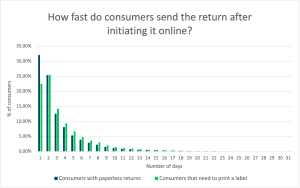Facts and Figures, Press Pieces, Sustainability
Ditching the Paper: How Paperless Returns Can Revolutionize Your Brand's Return Experience
As online shopping continues to rise in popularity, so too does the need for efficient and convenient return processes. It’s important to provide your consumers with a seamless return experience and fast refund that leaves a good impression, or you might risk losing their business.
One major bottleneck for consumers in the return process is the need to print out labels. Nowadays, people have increasingly less need to have their own printers as most things have become digital. Without a printer at home, consumers are stuck printing out return labels at work, asking friends or neighbors, or needing to drive to a copy shop which turns the returns process into a big hassle.
Some retailers are making the returns process easier for customers by putting pre-printed labels in outbound shipments, but this is both costly and not sustainable since not all consumers end up using them. On the other hand, paperless returns are an easy and sustainable alternative that is gaining popularity due to the convenience they provide to consumers. In this blog, we’ll explore what paperless returns are, how they work, and the benefits they offer both retailers and customers.
What are paperless returns?
Paperless returns eliminate the need for physical return labels and paperwork. Instead, the return process is entirely digital, with customers receiving a QR code or another digital label to display on their mobile device when they drop off their package. This label contains all the necessary information for the return, such as the customer’s order number, return address, and tracking information.
How do paperless returns work?
The paperless returns process typically starts with the customer initiating the return through the retailer’s website or app. The customer provides the reason for the return and any necessary details, such as the item’s condition and packaging. The website then generates a QR code containing the digital return label and sends it to the customer. The customer can then go to a drop-off location, simply show the QR code and drop off the package that needs to be returned. This also works in a similar way when returns are picked up by a courier.
In our research, when given a choice, more than 50% of people choose to use paperless labels. This data makes a compelling case for retailers to begin offering paperless returns. But consumers aren’t the only ones benefiting from paperless labels. Our data also shows that 30% percent of consumers who chose paperless returns, end up sending the package within the same day of creating the return online, proving that convenience propels consumers to return items faster. This, in turn, can help retailers get items back to stock more quickly and recover more value.

Benefits of paperless returns for retailers
Implementing paperless returns offers several benefits for retailers, including:
- Cost savings: By utilizing paperless returns, retailers no longer need to spend money putting labels in outbound shipments. Additionally, consumers return unwanted items faster since it’s more convenient, helping retailers recover more value.
- Improved efficiency: Because paperless returns are entirely digital, the process can be faster and more streamlined. This can lead to faster processing times, which can improve customer satisfaction and reduce the number of customer service inquiries related to returns.
- Increased sustainability: By eliminating the need for physical return labels and paperwork, retailers can reduce their environmental impact and demonstrate their commitment to sustainability.
- Increased brand loyalty: Since consumers know it’s easy to return unwanted items, they will be more likely to become repeat shoppers and stick with your brand.
The Case for Paperless Returns
In summary, paperless returns offer a convenient, efficient, and sustainable alternative to traditional return processes. By eliminating the need for physical labels and paperwork, retailers can save costs, improve efficiency, and demonstrate their commitment to sustainability. Meanwhile, customers can enjoy a more convenient and faster return experience, with less hassle and reduced environmental impact.
As online shopping continues to grow and consumers demand an ever-more seamless experience, it’s likely that more retailers will follow suit and adopt paperless returns to stay competitive. If you’re keen to introduce paperless returns, we’re here to help. At ReBound, we have a vast network of local carriers and postal companies, with more and more of them introducing the support of paperless returns. One good example is InPost, which provides paperless returns in countries like France, UK, Poland, and more.
At ReBound, we pride ourselves on helping our clients create seamless, cost-effective, and sustainable return solutions. With our advanced returns technology and vast network, we can help you implement paperless returns and other environmentally friendly initiatives to lower the overall carbon footprint of your return operations. Interested in more sustainable, cost-saving initiatives? Check out our recent ebook “How Sustainability Measures Can Decrease the Cost of Returns”.
